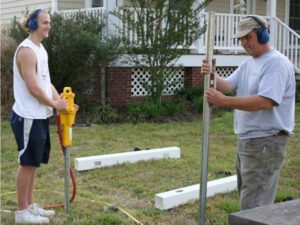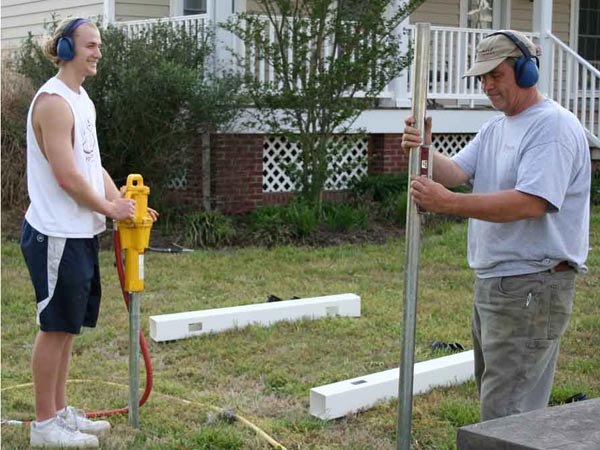It is important to know that vinyl fences are made to be long-lasting and will look great for years to come. They are also a lot more affordable than many other fencing options.

Homeowners who choose to DIY their vinyl fencing project often encounter challenges due to a lack of knowledge on how to do the job correctly. Following these tips can help ensure that your fence is installed properly.
A well-built vinyl fence is a durable, long-lasting home improvement that adds security, privacy, and curb appeal. It also keeps pets and children safe, helps keep yard waste contained, and dampens noise. However, the upfront cost of a vinyl fence is higher than other fencing materials. That’s why it’s important to avoid pitfalls that can eat into those savings and shorten the life of the project.
Post installation is a vital part of any fence project, and it’s particularly important with vinyl. This is because the material expands and contracts with changing weather conditions. If the posts aren’t properly installed, it could lead to gaps in your new fence or even structural damage. To prevent this, first ensure the ground is level and dry. Then, dig holes for each post to a depth of one-third of the overall length of the post. After digging each hole, mix concrete and pour it into the holes. When the cement sets, use a level to make sure each post is plumb from front to back and side to side.
Unlike wood, vinyl is resistant to moisture. This makes it more able to stand up to the harsh Minnesota winters, where snow can wreak havoc on wooden fences. Additionally, vinyl is less prone to mold and insect infestations. Despite these advantages, your vinyl fence may still be vulnerable to surface damage or cracking. These problems can be caused by a number of factors, including the weather or simply the wear and tear of daily use.
Many homeowners will want to stain or paint their vinyl fence, but this is not recommended. Although it might improve the look of your fence, staining or painting will actually weaken the vinyl. Instead, a vinyl fence patch kit can be used to repair any surface damage and save you from having to replace your whole fence. The kits contain special tools that are easy to use and will help you restore your vinyl fence so it looks like new in no time. The best thing about vinyl fence patches is that they are quick and affordable, reducing your total costs of installation and maintenance.
Panel Installation
When installing vinyl fences, it’s important to take your time and follow the instructions provided. Fences should be built in stages to ensure that they are level. Focusing on one panel at a time will also help you avoid mistakes that can be costly down the road, like misalignment.
After the posts are installed, you can begin assembling the fencing panels. Many vinyl fences feature a snap-together design that resembles the model kits you built as a kid. This can make the process quick and easy, but be sure to pay attention to your work. If you aren’t careful, you may end up with an uneven or crooked fence that will be difficult to repair later on.
Once the panels are in place, it’s a good idea to reinforce them with concrete. This will make your fence stronger and less likely to blow down in strong winds. To do this, dig holes that are a third of the post’s length and add concrete to the bottom of each hole. Follow the manufacturer’s instructions for how to properly mix and pour concrete for your specific fence type.
After a day or two, the concrete should have had time to set. At this point, you can add a gate to your fence, if desired. It’s also a good idea to add post caps to your fence posts, as these will prevent water and debris from collecting on the top of your posts.
With their long-lasting durability and attractive appearance, vinyl fences can boost the value of your property. They are available in a wide range of styles, so you’re sure to find one that matches your home. In addition, vinyl fences are much cheaper than other fencing materials and require minimal maintenance. For these reasons, it’s best to hire a professional company for your vinyl fence installation.
Post Repair
Vinyl fences are extremely durable, but that doesn’t mean they’re immune to damage or the effects of inclement weather. For example, a heavy wind or freezing rain may cause a few broken pickets or rails to fall off your vinyl fence. A good rule of thumb is to replace any broken pieces or sections that aren’t aligned correctly. You’ll want to do so in a way that doesn’t compromise the structural integrity of the rest of your fence.
If you have a full-panel privacy fence, it’s especially important to have strong posts because they are more exposed to the elements. Using concrete in the foundation of the posts helps keep them from shifting or tipping over time. Depending on where you live, you may also need to treat them for termite prevention. Here in Missouri, we have a big problem with subterranean termites, so it’s best to take precautions to avoid this kind of pest damage.
A broken post is a bit more complicated to fix than a loose or misshapen panel or rail. First, you’ll need to remove the rails and panels fixed to the broken post. This process is fairly easy and can be done with a power screwdriver or other tool. Then, dig out the old post and any fragments of concrete holding it in place. You can then put in a new post, making sure it’s properly secured and aligned with the rest of your vinyl fence.
Another common repair is for scratches or dings in your vinyl fence. For minor surface damage, you can use plastic filler or vinyl patching compound. These can be purchased at most home improvement stores or online. Follow the manufacturer’s instructions for application, then let the product dry completely. For more serious scratching or dings, you may need to sand the area until it’s smooth and flush with the rest of your vinyl fence.
If you’re not confident in your ability to perform these repairs yourself, a local fencing company is likely able to help at affordable rates. Just be sure to choose a reputable and experienced business that knows what they’re doing when it comes to installing and repairing vinyl fences.
Post Replacement
A vinyl fence is a great option for homeowners who want to make their yard look better while adding security. This type of fence is manufactured with precision and contains materials that are resistant to the elements that cause decay in organic wood products. Nevertheless, this type of fence does require regular maintenance to keep it looking good and working well.
If you notice that your vinyl fence has some issues, such as loose or broken panels or a sagging or collapsed section of the fence, you should take action to fix these problems before they lead to larger problems. This may include repairs or replacements to the posts, rails, and pickets. If you aren’t sure which parts of the fence need repair, consult your manufacturer’s instructions. Generally, these instructions should provide specific information to help you identify the problem and the part that needs to be replaced.
Before you begin working on any vinyl fence repair, it’s a good idea to wipe away any physical debris that might be in the area. Then, use a rag soaked in isopropyl alcohol to thoroughly clean the area and remove any residual dirt or oil. Once the surface of the vinyl is clean, you can start repairing the damage to the post.
First, you’ll need to fill the hole in the post with a foam sealant that matches your fence color. This will ensure that the repair blends seamlessly with the rest of your fence. When the sealant is dry, you can then apply auto body filler to the repair spot. This will also help to seal the opening and make it smooth.
Once the repair spot is smooth, you can add the new panel to the post. Most vinyl fences have interlocking panels that lock in place without fasteners, but you should check your manufacturer’s instructions to ensure that you are installing the new panel properly.
If your vinyl fence requires reinforcement, you can increase its rigidity by adding metal sleeve inserts to the post. These sleeve inserts are available in a variety of different design options, so you should be able to find one that is appropriate for your fence’s needs.







 Once the fire has burned through, and all the smoke has cleared, the next step for a fire damage restoration specialist is to assess the extent of the damage. The extent of the damage will determine the best course of action to take. Typically,
Once the fire has burned through, and all the smoke has cleared, the next step for a fire damage restoration specialist is to assess the extent of the damage. The extent of the damage will determine the best course of action to take. Typically,